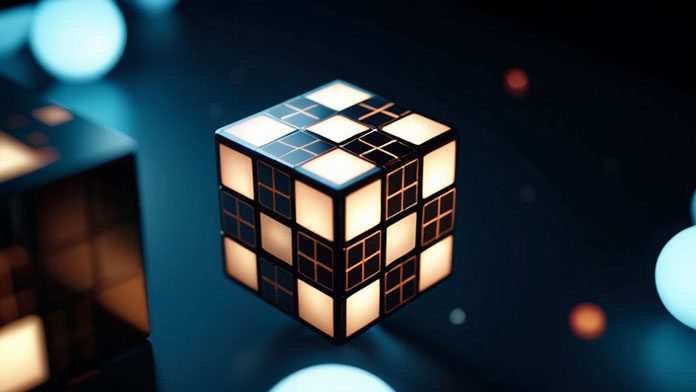Imagine if you could effortlessly manipulate objects in your mind, effortlessly rotating them to see them from different angles. This incredible ability is known as mental rotation, and it plays a crucial role in our cognitive processes.
In this article, we will delve into the fascinating world of mental rotation, exploring what it is and how it works. By understanding this cognitive process, you can gain valuable insights into spatial reasoning and improve your own mental rotation skills.
Table of Contents

Related Video: "Mental rotation - Intro to Psychology" by Udacity
Main Points
– Mental rotation is the cognitive process of mentally manipulating objects or images in the mind.
– Mental rotation ability varies among individuals and is influenced by factors such as spatial ability, working memory capacity, and training.
– Mental rotation contributes to problem-solving abilities and enhances cognitive processes such as problem-solving, navigation, and understanding spatial relationships.
– Techniques for improving mental rotation skills include engaging in activities that require spatial visualization, mental rotation training, incorporating hands-on activities, and using visual imagery techniques.
The Definition of Mental Rotation

To understand mental rotation, you need to grasp its definition and how it works. Mental rotation refers to the cognitive process of mentally manipulating objects or images in your mind. It involves mentally rotating an object or image to determine if it matches another object or image. This cognitive process allows us to understand and perceive spatial relationships between objects.
The definition of mental rotation has been extensively studied in the field of cognitive psychology. Researchers have found that mental rotation involves several cognitive processes, including visual imagery and spatial reasoning. When you engage in mental rotation, you create a mental representation of the object or image and manipulate it mentally to assess its similarity or difference with another object or image.
Studies have shown that mental rotation ability varies among individuals, with some people demonstrating higher proficiency in this cognitive process than others. It’s believed that mental rotation ability is influenced by factors such as spatial ability, working memory capacity, and training. Furthermore, research has demonstrated that mental rotation plays a crucial role in various domains, including mathematics, science, and athletics.
The Importance of Mental Rotation in Cognitive Processes

Mental rotation plays a crucial role in cognitive processes, offering numerous cognitive benefits. One important benefit is its contribution to problem-solving abilities. Research has shown that individuals with strong mental rotation skills are often better at visualizing and manipulating complex objects in their minds, allowing them to approach problem-solving tasks with greater efficiency and accuracy.
Additionally, mental rotation has been linked to improved spatial reasoning and spatial awareness, further highlighting its significance in cognitive processes.
Cognitive Benefits of Rotation
As you explore the cognitive benefits of mental rotation, you’ll discover its importance in various cognitive processes. One of the main cognitive benefits of mental rotation is its impact on spatial reasoning. Spatial reasoning refers to the ability to mentally manipulate and transform objects in space.
Studies have shown that individuals who are skilled at mental rotation tasks also tend to have stronger spatial reasoning abilities. This is because mental rotation requires the ability to mentally visualize and manipulate objects in three-dimensional space. By engaging in mental rotation exercises, you can improve your spatial reasoning skills, which can have a positive impact on various cognitive processes such as problem-solving, navigation, and understanding spatial relationships.
Therefore, mental rotation plays a crucial role in enhancing cognitive functioning, particularly in tasks that involve spatial reasoning.
Role in Problem-Solving
You can utilize mental rotation in problem-solving to enhance your cognitive processes. Mental rotation is a valuable tool that allows you to mentally manipulate objects or concepts in your mind. By mentally rotating these objects, you can gain a different perspective and find innovative solutions to complex problems.
In problem-solving, mental rotation can be used to visualize different scenarios, explore various possibilities, and devise effective strategies. By mentally rotating objects or concepts, you can identify patterns, make connections, and generate new insights. This cognitive process can be particularly helpful in fields that require spatial reasoning, such as architecture, engineering, and mathematics.
To further understand the role of mental rotation in problem-solving, consider the following table that outlines different problem-solving techniques and strategies:
| Technique | Description | Example |
|---|---|---|
| Trial and Error | Trying different solutions until the correct one is found | Attempting multiple approaches to a math problem |
| Algorithm | Step-by-step procedure or formula for solving a problem | Following a recipe to bake a cake |
| Heuristics | Mental shortcuts or rules of thumb used to solve problems quickly and efficiently | Guessing the answer based on previous experience |
| Analogical Reasoning | Drawing connections between similar problems to solve a new problem | Using a solution from a previous project |
| Decomposition | Breaking down a complex problem into smaller, more manageable parts | Breaking down a research paper into sections |
The Cognitive Processes Involved in Mental Rotation

Your brain’s cognitive processes play a crucial role in mental rotation. Cognitive development refers to the growth and changes that occur in a person’s ability to think, reason, and understand over time. Mental rotation, being a complex cognitive task, requires various cognitive processes to be engaged.
One key cognitive process involved in mental rotation is visual perception. When presented with an object or shape, your brain processes the visual information and extracts relevant features such as size, shape, and orientation. This information is then used to mentally manipulate the object and mentally rotate it in your mind’s eye.
Additionally, working memory plays a vital role in mental rotation. As you mentally rotate an object, you need to hold the original image in your mind while simultaneously manipulating it to its new orientation. Working memory helps you keep track of the object’s original position and the changes you make during the rotation.
Furthermore, attention and executive functions are crucial cognitive processes in mental rotation. Attention allows you to focus on the relevant features of the object, while executive functions help you plan and execute the mental rotation task effectively.
The Role of Mental Rotation in Spatial Reasoning
Mental rotation plays a significant role in spatial reasoning as it allows you to mentally manipulate and visualize objects in different orientations. This ability is crucial in various cognitive tasks, including navigation and spatial memory. By mentally rotating objects, you can understand how they relate to the surrounding space and make accurate judgments about their positions and orientations.
One way to understand the role of mental rotation in spatial reasoning is to examine its impact on navigation. When navigating through an environment, you often need to mentally rotate maps or visualize paths from different perspectives. This skill enables you to understand the spatial relationships between landmarks, estimate distances, and plan efficient routes.
Furthermore, mental rotation also influences spatial memory. When you mentally rotate objects, you create multiple mental representations of the same object, each corresponding to a different orientation. This process enhances your ability to remember and recognize objects in different orientations, allowing for more flexible and accurate spatial memory.
To further illustrate the role of mental rotation in spatial reasoning, consider the following table:
| Cognitive Process | Description |
| Mental Rotation | Ability to mentally manipulate and visualize objects in different orientations. |
| Navigation | Using mental rotation to understand spatial relationships, estimate distances, and plan routes. |
| Spatial Memory | Enhanced ability to remember and recognize objects in different orientations. |
Factors Affecting Mental Rotation Abilities
One factor that can affect your mental rotation abilities is the complexity of the objects being rotated. Research has shown that the more complex an object is, the more difficult it becomes to mentally rotate it. This is because complex objects have more intricate details and irregular shapes, requiring more cognitive effort to imagine them in different orientations.
Factors affecting mental rotation abilities:
– Object complexity: As mentioned earlier, complex objects are more challenging to mentally rotate due to their intricate details and irregular shapes.
– Spatial ability: Individuals with higher spatial ability tend to perform better in mental rotation tasks. Spatial ability refers to the capacity to understand and manipulate spatial relationships, which is crucial for mental rotation.
– Prior experience: Previous experience with mental rotation tasks can improve performance. Practice and exposure to mental rotation exercises can enhance the ability to mentally manipulate objects.
– Gender: Studies have shown that males tend to outperform females in mental rotation tasks. However, it’s important to note that these gender differences aren’t absolute and can vary among individuals.
Understanding the factors that affect mental rotation abilities can have cognitive benefits. By identifying these factors, researchers and educators can develop interventions and training programs to improve mental rotation skills. This has the potential to enhance spatial reasoning and problem-solving abilities in various fields, such as mathematics, engineering, and architecture.
Techniques and Strategies for Improving Mental Rotation Skills
To improve your mental rotation skills, it’s important to practice various techniques and strategies. One effective technique is improving spatial visualization. This involves mentally manipulating and rotating objects in your mind’s eye. By regularly engaging in activities that require spatial visualization, such as puzzles or building blocks, you can enhance your ability to mentally rotate objects.
Another strategy for improving mental rotation skills is through mental rotation training techniques. One popular method is the use of mental rotation tasks. These tasks involve mentally rotating two-dimensional or three-dimensional objects and determining if they’re the same or mirror images. By consistently practicing these tasks, you can strengthen your mental rotation abilities.
Additionally, research suggests that incorporating hands-on activities can be beneficial in improving mental rotation skills. For example, engaging in activities that involve physically manipulating objects, such as assembling puzzles or building models, can enhance your spatial visualization and mental rotation abilities.
Furthermore, incorporating visual imagery techniques can also aid in improving mental rotation skills. For instance, actively visualizing objects rotating in your mind and mentally tracking their movements can enhance your ability to mentally rotate objects.
Applications of Mental Rotation in Various Fields
You can find applications of mental rotation in various fields, such as psychology, neuroscience, and education.
The concept of mental rotation has proven to be valuable in understanding various aspects of human cognition and behavior.
In the field of psychology, mental rotation tasks have been used to assess spatial abilities and cognitive processes. For example, researchers have used mental rotation tasks to study the impact of gender differences on spatial ability.
In neuroscience, mental rotation has been studied to gain insights into the neural mechanisms underlying spatial processing. Neuroimaging techniques, such as functional magnetic resonance imaging (fMRI), have revealed the brain areas involved in mental rotation tasks.
In the field of education, mental rotation tasks have been incorporated into educational programs to improve spatial skills in students. These tasks have been found to enhance not only spatial abilities but also other cognitive skills, such as problem-solving and critical thinking.
Additionally, mental rotation has found applications in sports, where athletes often need to mentally rotate objects or anticipate the movements of their opponents. Understanding the impact of mental rotation on visual perception can provide valuable insights into sports performance and training strategies.
The Future of Mental Rotation Research
As you consider the future of mental rotation research, several important points come to mind.
Firstly, there’s a need for the development of new experimental techniques that can further explore the underlying mechanisms and processes involved in mental rotation. These techniques could provide a deeper understanding of how mental rotation works and potentially lead to new insights and discoveries.
Secondly, the implications for education are significant, as mental rotation skills have been linked to spatial reasoning and math abilities. Future research could explore how mental rotation training programs can be incorporated into educational curricula to enhance these skills.
Lastly, there may be potential clinical applications for mental rotation research, such as aiding in the diagnosis and treatment of spatial cognition and perceptual disorders.
New Experimental Techniques
Researchers frequently employ novel experimental techniques to explore the future of mental rotation research. These experimental approaches and novel methodologies offer fresh insights and contribute to the advancement of our understanding of mental rotation. Here are four key techniques that researchers are currently utilizing:
– Virtual Reality (VR): By immersing participants in a virtual environment, VR allows for a high level of control and manipulation of stimuli, providing a realistic and interactive experience for studying mental rotation.
– Neuroimaging: Techniques such as functional Magnetic Resonance Imaging (fMRI) and Electroencephalography (EEG) enable researchers to observe the brain activity associated with mental rotation, shedding light on the neural processes involved.
– Eye-tracking: By tracking participants’ eye movements during mental rotation tasks, researchers can gain valuable insights into the cognitive processes and strategies used, further enhancing our understanding of mental rotation.
– Transcranial Magnetic Stimulation (TMS): By applying magnetic pulses to specific areas of the brain, TMS allows researchers to temporarily disrupt or enhance neural activity, providing causal evidence for the involvement of certain brain regions in mental rotation.
These innovative techniques hold great promise for uncovering new findings and expanding our knowledge of mental rotation.
Implications for Education
To fully grasp the potential impact of mental rotation research on education, it’s essential to explore the future implications and advancements in this field. Understanding how mental rotation works can inform teaching strategies and improve learning outcomes for students.
By incorporating mental rotation tasks into the curriculum, educators can enhance spatial reasoning skills, which are crucial for success in various STEM fields. Research has shown that training in mental rotation can lead to improvements in problem-solving abilities, visualization skills, and overall cognitive flexibility.
Furthermore, advancements in technology, such as virtual reality, can provide more immersive and engaging experiences for students, allowing them to practice mental rotation in a realistic and interactive manner.
Potential Clinical Applications?
For individuals with certain neurological conditions, such as autism or traumatic brain injury, mental rotation research holds potential for developing innovative therapeutic interventions. Understanding how mental rotation works and its impact on cognitive processes can help researchers design targeted interventions to improve cognitive abilities in these individuals.
Some potential therapeutic interventions that could arise from mental rotation research include:
– Virtual reality training programs: Using virtual reality technology, individuals can engage in mental rotation tasks in a controlled and immersive environment, allowing for repeated practice and feedback.
– Cognitive rehabilitation programs: Mental rotation assessment can be used to identify specific areas of cognitive impairment and develop tailored rehabilitation programs to target these deficits.
– Assistive technology: Applying mental rotation research to the development of assistive technologies can help individuals with neurological conditions perform daily tasks more independently.
- Educational interventions: Incorporating mental rotation tasks into educational curricula can enhance spatial reasoning skills in individuals with neurological conditions, improving their overall cognitive functioning.
Frequently Asked Questions
What Are Some Common Misconceptions About Mental Rotation?
You may have some misunderstandings about mental rotation. Common myths include thinking it's solely related to spatial abilities and that it's a fixed trait. However, research shows it can be improved with practice and is influenced by various factors.
Can Mental Rotation Abilities Be Improved Through Practice and Training?
Practice and training can indeed improve your mental rotation abilities. Effective methods include spatial visualization exercises and video game training. Long-term practice leads to significant improvement, as shown by numerous studies.
How Does Mental Rotation Relate to Other Cognitive Abilities, Such as Problem-Solving or Decision-Making?
Understanding the relationship between mental rotation and creative thinking is crucial. Mental rotation plays a significant role in problem-solving strategies, as it allows you to manipulate and visualize objects mentally, aiding in decision-making processes.
Are There Any Gender Differences in Mental Rotation Abilities?
Are there any disparities in performance between genders in mental rotation? How do societal norms influence this cognitive skill? Research indicates that there may be slight differences, but the role of cultural factors needs further investigation.
How Does Age Affect Mental Rotation Skills? Are There Any Developmental Changes in This Ability?
As you age, there are developmental changes in your mental rotation abilities. Research suggests that mental rotation skills may decline with age, although the extent of decline varies among individuals.


